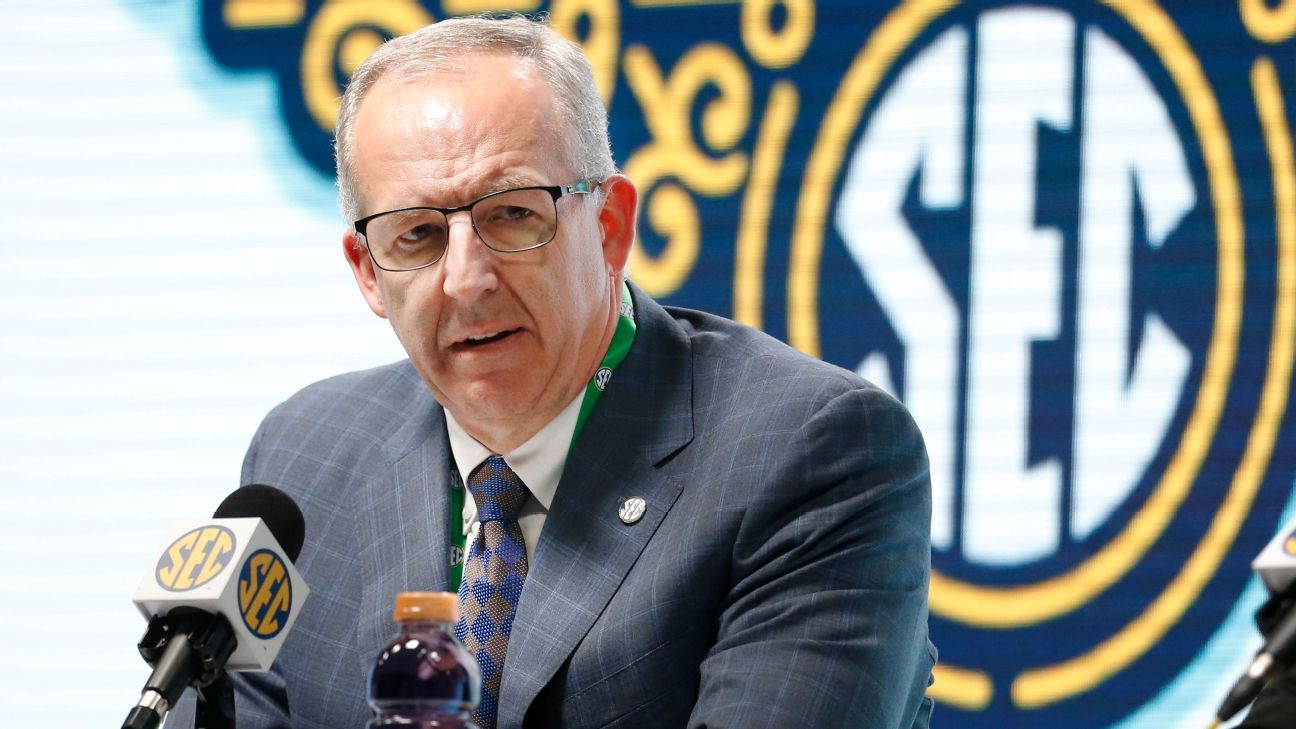SEC commissioner Greg Sankey said “there’s a little tinge of sadness – probably more than just a little tinge,” to see the Pac-12 on the verge of collapse after more than 100 years of existence, and as the flurry of events unfolded last week that ultimately left the Pac-12 with four teams, “it just wasn’t one of those great feelings to work in college sports in my experience.”
“I take responsibility where we’ve made moves,” Sankey said during a lengthy interview on the Paul Finebaum Show on Tuesday. “But there was something different last week about the questions around the existence of the Pac-12 conference, given its long and storied history.”
Last week, Washington and Oregon announced their intent to join the Big Ten, and Arizona, Arizona State and Utah decided to join the Big 12. The drastic decisions left Washington State, Oregon State, Stanford and Cal looking for a conference home in 2024 if the Pac-12 isn’t capable of piecing itself together again.
Sankey said he called Washington State athletic director Pat Chun and Stanford athletic director Bernard Muir to tell them, “I don’t have any solutions, but I have great empathy.”
While the Pac-12 was amid uncertainty, Florida State president Richard McCullough unabashedly told the board of trustees in a public meeting that the Seminoles would “very seriously” consider leaving the ACC unless there is a radical change to the league’s revenue distribution model. That of course prompted speculation of where FSU would possibly go, and Sankey was with his conference athletic directors at a Cubs game in Chicago when people began reaching out to him about the volatility of it all.
“I’ve opined publicly that I think the speculation in some of the pronouncements we’ve seen since that time about growth or directional growth is problematic,” he said, “Even for me, with the security of the Southeastern Conference, whether it was Friday afternoon or Saturday fielding phone calls, which really were more conversations, ‘what do you think’s happening?’ There’s nobody calling me seeking or demanding entry, a lot of commentary publicly.”
Sankey reiterated his conference isn’t actively recruiting any additional schools, but said the league is “constantly attentive” to the shifting collegiate landscape around it. He said last week, behind the scenes, the conference office had “different types of daily communications with our campuses to say, ‘here’s what we understand is taking place.'”
The SEC presidents and chancellors had a videoconference at the end of the week during which Sankey said there was a “really strong alignment with that group, very clear that there’s not something out there that we should be reaching for or engaging in.”
As the Big Ten now stretches from coast to coast, Sankey has been firm in his stance that the SEC is comfortable with its current geographical footprint.
“We don’t need to be in four time zones to generate interest on the West Coast or really across the globe,” he said, “and so that’s been a hallmark. Who knows what will happen, and that’s where I go back to one of my original statements – we’re always going to be attentive to what’s happening around us. And perhaps there’ll be some opportunity, but it needs to be a lot of philosophical alignment. And it’s not something where we’re actively out recruiting institutions right now.”
Sankey is one of 10 FBS commissioners who oversee the format of the College Football Playoff, and he was one of the original authors of the 12-team format, which will begin in time for the 2024 season. The current model includes the six highest-ranked conference champions, plus the next six highest-ranked teams.
If the Pac-12 dissolves – which many sources expect it to – the commissioners and Notre Dame athletic director Jack Swarbrick, who is also on the CFP management committee, would likely revisit how the 12 teams are chosen.
“I think it’s wise for us to take a step back and reconsider what the format might look like given these changes and circumstances,” Sankey said. “We’ve not met on that, I’ve not had any meaningful conversations, but I think we have to acknowledge that it is on everyone’s mind pending the outcome of some of these additional membership movement pieces.”
Sankey said he has been an advocate long before the recent events to look carefully at their decisions around seeding and location.
“Now here we are with more membership movement questions about how many conferences will exist,” he said. “It just raises the questions that are not fully back to a starting point about conference champion access, about how a bracket is seeded, particularly the adjustment around Notre Dame remaining an independent not having that top-four seed status. Those matters really need to be dug into and understood.”
